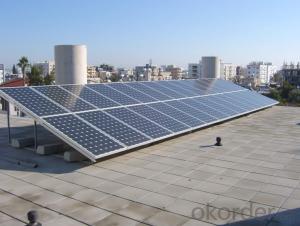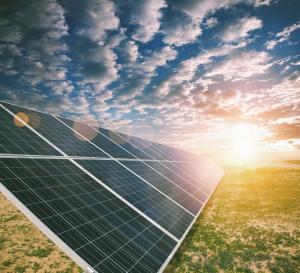Solar Panel 305w Silicon Polycrystalline
- Loading Port:
- Guangzhou
- Payment Terms:
- TT OR LC
- Min Order Qty:
- 200000 watt
- Supply Capability:
- 20000000 watt/month
OKorder Service Pledge
OKorder Financial Service
You Might Also Like
INTRODUCTION
We are a high-tech group wich specializes in solar products design,research, manufacture, sales,solar projects design and installation.
Our national sales service covers seven parts, including northeast, north, east, middle, south, northwest and southwest, international sales covers five continents and over forty countries, including Germany, Italy, Spain, France, America and Brazil etc.
Our present annual capacity is 6 million for wafer, 60MWp for solar cells,200MWp for solar modules and one hundred thousand for solar applications. It is expected that the annual capacity of 2012 will be up to 30 million for wafer, 300MWp for solar cells, 1000MW for solar modules and 2 million for solar applications.

This installation Manual contains essential information for the electrical and mechanical installation that your must know before installing CUSTOMER PV modules. This also contains safety information you need to be familiar with .All the information described in this manual are the intellectual property of CNBM and based on the technologies and experiences that have been acquired and accumulated in the long history of CUSTOMER. This document does not constitute a warranty, expressed or implied.
DATA SHEET
Maximum Power | 305W |
Efficiency | 0.157 |
Backsheet | Silver |
Frame Colar | White |
Manufacture Site | China |
Frame | Anodized Aluminum Alloy |
Weight | 27 kg |
FAQ:
1. How long will my inquiry get response?
Your inquiry related to our products or prices will be replied within 24 hours.
2. Can I get professional service and suggestion?
Well-trained and experienced staffs to answer all your questions in fluent English.
3. Do you accept OEM or customized design?
OEM & ODM, any your customized lightings we can help you to design and put into product.
4. What if I need specific design?
Distributorship are offered for your unique design and some our current models.
- Q:I need to reduce the average monthly home electricity bill by powering some of the household appliances using solar panels. Can I use a 250 watt solar panel to power a medium sized upright fridge?
- How many watts does your fridge consume? Do you want it to work at night when the solar panels aren't doing anything? Probably not.
- Q:i need to make a solar panel model for a project in science and i would like to know how to build a easy model at home that wont cost alot
- There are different types of solar panels. Photovoltaic for electricity, and thermal for heating water, and passive for heating air. So it would help if you would say what type you are going to build. Theere are a lot of videos on you tube on how to make solar panels. use the link below.
- Q:Can solar panels be installed on a rental property?
- Yes, solar panels can be installed on a rental property. However, it ultimately depends on the landlord's consent and willingness to invest in the installation.
- Q:I am thinking of buying a 3w solar panel called the nomad 3 from goal zero. I want to charge 35Wh lithum batteries. I have heard that lithium batteries are temperatmental and without a regulated current things could get ugly.I have a couple of chargers that came with the batteries. One is a 2v car charger and another is 0-240v wall charger.Goal zero sell something called a sherpa 50, which contains rechargeable batteries and an inverster and I think they suggest that I charge my batteries indirectly through the Sherpa 50, however, the sherpa 50 is expensive at $200, and seems to have a small capacity, in addition to being extra weight that i don`t want to carry.Electronics geniuses, you are my only hope.
- Lithium batteries do have special charging requirements. I would recommend that you use the 2 volt charger that came with them to keep them happy. Automotive power systems can have voltages as high as 4.5 volts when the engine is running so there's no need to limit the output of the panel to anything less than that. Check with the charger manufacturer to see what it will withstand. Some will work with systems up to 24 volts nominal (up to 29 volts actual) found in larger commercial vehicles such as trucks and busses. If your charger will work with both 2 and 24 volt systems you might not need anything extra to use the unregulated output of the panel. Otherwise I'd recommend a shunt regulator to clamp the output of the panel to no more than 4.5 volts. That way it would dissipate (waste) very little of the panel's power, and even that would only be during those rare times when the panel is producing maximum output. Such a device could be as simple as a high power zener diode, a low power zener coupled with a power transistor, or a precision shunt regulator such as a TL43 coupled with a power transistor. A more complex way would be a to use buck/boost regulator between the panel and your charger. You might gain a slight advantage under low light conditions when the panel isn't putting out much but the overall efficiency could end up worse than the simpler shunt regulator. Under optimum conditions, I would expect it to take a full day for a 3 watt (peak) panel to charge just one of your 35 Wh batteries. Charging an intermediate device such as the Sherpa 50 through its built in charger and then using it to charge your battery through yet another charger would severely cut your overall efficiency. Depending on how long you'll be gone, it might be far more practical, reliable, and economical to just carry (or find a way to be resupplied with) a few additional fully charged 35 Wh batteries. Don
- Q:I am fairly new to the solar panel scene, and am eager to try to set one up myself instead of buying a kit. I am looking for a solar panel that puts out 00 Watts or more, and can produce more than 20 volts. Thanks
- a cheap one that doesn't burn up
- Q:I've built a set of lights, fan and a clock running on only solar power. The problem is, i have to present it tomorrow and when the light isn't particularly strong it won't work too well. It works flawlessly when its under my desk light on max brightness but the only the light works when i set it to low brightness. Currently, tomorrow in my city it won't be sunny so any advice for trying to make it work under low light?
- Solar panels are designed to be used to recharge a battery or series of batteries, not for direct power. That is the inherent weakness of solar systems. The only way to have it work in low light conditions if to have several cells wired in series and have a voltage regulator to limit the amount of voltage that can be supplied. Other than that, add a battery and a charging circuit that the cell would supply power to.
- Q:I'm trying to charge rechargeable AA batteries with a solar panel. What guage wire should I use to connect the panel to the batteries? Should I use a diode to keep the batteries from overpowering the circuit? If so, what size? My panel is 4.8V 50mA.
- With that size panel, you should be able to recharge either AA battery, or two AA batteries in series. Yes, it would be a good idea to put a blocking diode in series with the panel - anything will do, like a N448. You will want to use NiCd batteries if possible, because they take a trickle charge of 50 mA much better than NiMH (which prefers pulse charging, a more complicated circuit). You can use NiMH if you must. Needless to say, don't try to charge non-rechargable batteries. Also realize that at this charge rate, it will take days, maybe even a week, to charge the batteries, if left out in full sun all day long.
- Q:How do solar panels impact the electric bill?
- Solar panels can significantly reduce or even eliminate the electric bill for homeowners. By generating clean and sustainable energy from sunlight, solar panels can offset the amount of electricity needed from the grid. Excess energy produced by solar panels can be fed back into the grid, earning credits or monetary compensation through net metering. Ultimately, solar panels can lead to substantial savings on the electric bill over time.
- Q:Do I just run the wire from the panel into the charge controller and then to the battery AND can I simultaneously draw energy from the battery while it is being charged by the panel?Is it as simple as hooking it up like that?
- I hope you have some instructions. You need safety switches and fuses in the circuit. What voltage/currents are you running? Don't burn the house down or get electrocuted please. DC can be very dangerous.
- Q:if i have a 0 Watt solar panel what does that mean. does that mean it will charge a battery 0 watts per hour? Lets say i hook this up to a car battery and use the car battery to run computer stuff. How much will this charge the battery?
- It will be less than a trickle charger on the battery. It is about .85 amps at 2 volts dc.
1. Manufacturer Overview |
|
|---|---|
| Location | |
| Year Established | |
| Annual Output Value | |
| Main Markets | |
| Company Certifications | |
2. Manufacturer Certificates |
|
|---|---|
| a) Certification Name | |
| Range | |
| Reference | |
| Validity Period | |
3. Manufacturer Capability |
|
|---|---|
| a)Trade Capacity | |
| Nearest Port | |
| Export Percentage | |
| No.of Employees in Trade Department | |
| Language Spoken: | |
| b)Factory Information | |
| Factory Size: | |
| No. of Production Lines | |
| Contract Manufacturing | |
| Product Price Range | |
Send your message to us
Solar Panel 305w Silicon Polycrystalline
- Loading Port:
- Guangzhou
- Payment Terms:
- TT OR LC
- Min Order Qty:
- 200000 watt
- Supply Capability:
- 20000000 watt/month
OKorder Service Pledge
OKorder Financial Service
Similar products
New products
Hot products





























